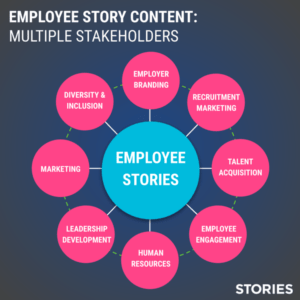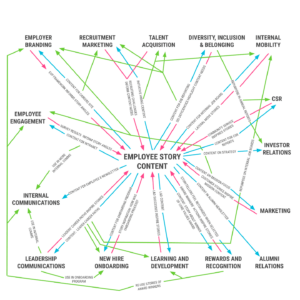What is culture content?
Culture content or culture communications is media that brings organizational culture to life. Communicating culture can be tricky: culture evolves constantly, and it is often considered an intangible and lofty concept.
What is the best form of culture communications?
For this reason, employee stories are considered the most effective way to communicate culture. They ground concepts like employer value propositions, values, and organizational commitments in tangible employee experiences. Specific employee stories show the impact of organizational decisions and culture; they also prove progress against organizational goals. Employee stories and experiences give real insight into a company’s culture for audiences like candidates, employees, customers, and more.
Why are employee stories the most effective culture content?
There are several reasons why employee story content often outperforms traditional marketing content by as much as 4x:
- Employees are the most trusted source for anyone wondering what the culture is like at a company.
- Stories are more engaging (and memorable) than any corporate platitude.
- Employee stories are the only way for organizations to prove they are who they say they are.
Why should marketers use culture content in their content marketing strategy?
Culture content is your most multi-faceted and hardest working marketing media. Every smart marketer and communicator should be using culture content in their content marketing efforts because:
- It’s one of the most versatile content types. Not only does it fit every platform but it appeals to multiple audiences.
- It’s the most engaging content. Stories about people and what an organization does to support them can outperform all other content by 4x.
- It’s the easiest way to communicate lofty concepts and plans related to DEI, values, and more.
What internal stakeholders can use culture communications?
Many groups within an organization need culture content, because the audiences they serve care about how a company is supporting their employees. Candidates are certainly seeking information about what the culture is like. Therefore, talent acquisition, employer branding and recruitment marketers must use employee stories often in their communications efforts.

But, alumni, current customers and sales prospects, employees, investors, and more are starting to care about a company’s culture too.
What are some good examples?
Check out a few of our favorite examples:
- Best Diversity and Inclusion Videos
- Best Company Culture Videos
- Best Company Culture Photos
- Stories Inc. case studies
For more insight into how smart marketers are using culture content to their advantage, download our Culture Content Audit and Planning Guide.


